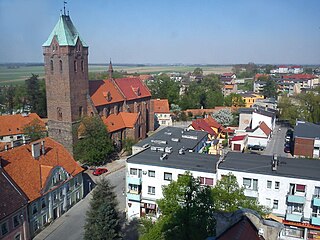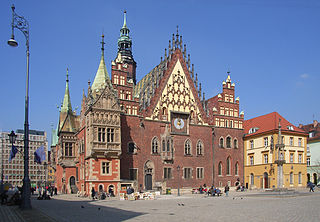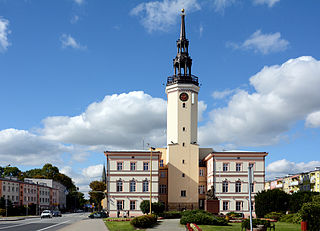
Tczew is a town on the Vistula River in Eastern Pomerania, Kociewie, northern Poland with 60,279 inhabitants. The city is known for its Old Town and the Vistula Bridge, or Bridge of Tczew, which played a key role in the Invasion of Poland during World War II.

Kraśnik is a town in southeastern Poland with 35,602 inhabitants (2012), situated in the Lublin Voivodeship, historic Lesser Poland. It is the seat of Kraśnik County. The town of Kraśnik as it is known today was created in 1975, after the merger of its two districts - Kraśnik Lubelski, and Kraśnik Fabryczny.

Lesko is a town in south-eastern Poland with a population of 5,755 (02.06.2009). situated in the Bieszczady mountains. It is located in the heartland of the Doły (Pits), and its average altitude is 390 metres above sea level, although there are some hills located within the confines of the city. Since 2002 it has been the capital of Lesko County.

City Hall is a civic building in Cathays Park, Cardiff, Wales, UK. It serves as Cardiff's centre of local government. It was built as part of the Cathays Park civic centre development and opened in October 1906. Built of Portland stone, it is an important early example of the Edwardian Baroque style. It is a Grade I listed building.

The Römer is a medieval building in the Altstadt of Frankfurt am Main, Germany, and one of the city's most important landmarks. The Römer is located opposite the Old St. Nicholas church and has been the city hall (Rathaus) of Frankfurt for over 600 years. The Römer merchant family sold it together with a second building, the Goldener Schwan, to the city council on March 11, 1405 and it was converted for use as the city hall. The Haus Römer is actually the middle building of a set of three located in the Römerberg plaza.

Szczecin Cathedral in Szczecin - was built by the citizens of the city and modeled after the Church of St Mary in Lübeck. It is the largest church in Pomerania and for many years after the reformation was part of the Pomeranian Evangelical Church, but since World War II and the handing over of Stettin from Germany to Poland it has been rebuilt as a Roman Catholic cathedral.

Poznań Town Hall is a historic city hall in the city of Poznań, Poland, located at the Poznań Old Town in the centre of Old Market Square. It used to serve as the seat of local government until 1939, and now houses a museum. The town hall was originally built in the late 13th century following the founding of the medieval city in 1253; it was rebuilt in roughly its present-day form, in mannerist style, with an ornate loggia, by Giovanni Battista di Quadro in 1550–1560. The display of mechanical fighting goats, played out daily at noon above the clock on the front wall of the building, is one of the city's main tourist attractions.

Byczyna is a town in Kluczbork County, Opole Voivodeship, Poland, with 3,582 inhabitants (2019).

The Old Town Hall, until 1874 the domicile of the municipality, serves today as a building for representative purposes for the city council in Munich. The Old Town Hall bounds the central square Marienplatz on its east side.

The Old Town Hall of Wrocław stands at the center of the city’s Market Square (rynek). The Gothic town hall built from the 13th century is one of the main landmarks of the city.

Brzeg Town Hall is a Renaissance building designed by Bernard Niuron built between 1569 and 1577. It is considered to be one of the most important Renaissance monuments in Poland. In addition to its role as the seat of the municipal government of Brzeg, the building houses several other institutions.

Głogówek Town Hall - a Renaissance building built in 1608, and in the subsequent years frequently renovated and reconstructed. In 1945, the building was partially burnt down, and later rebuilt between 1955 and 1957. Currently, the town hall is the seat for the Głogówek City Council.

Grodków Town Hall - a town hall built in the Classical architectural style in 1840, designed by architect Philippi, using the tower of the former town hall. Currently, the building is the seat of the Grodków City Council and other institutions.

Olesno Town Hall - a Classical architectural style building built between 1820 and 1821, in the location of a former building from the seventeenth-century. The building was expanded in 1880, and in 1945 burnt down, and subsequently rebuilt after World War II. Currently, the office space in the town hall is rented.

Opole Town Hall - a town hall built in the Neo-Renaissance architectural style in the Śródmieście borough in Opole. The town hall was built on the exemplar of the Palazzo Vecchio in Florence, Italy.

Strzelce Opolskie Town Hall - a Neo-Gothic building built between 1844 and 1846, in the location of a former, destroyed by fires town hall. In 1911, the town hall was reconstructed, in 1945 partially destroyed, and subsequently restored in the 1960s. Currently, the town hall is the seat for the Strzelce Opolskie City Council.

Gdańsk Main Town Hall is a historic Ratusz located in the Gdańsk Main City borough of Śródmieście. It is one of the finest examples of the Gothic-Renaissance historic buildings in the city, built at the intersection of Ulica Długa and Długi Targ, in the most popular part of Gdańsk. The Main Town Hall in Gdańsk houses the History Museum of the City of Gdańsk.

Hove Town Hall was constructed in 1970 in the Brutalist architecture style by John Wells-Thorpe. The current building replaced the original Hall that was built in 1882 and was damaged by fire in 1966.

The Town hall of Lubin - built in 1768 in Baroque style, rebuilt in the 19th century. The building was destroyed in 1945 and then rebuilt in 1950. Currently the town hall is a seat of the Historical Museum in Lubin and the Mayor as well as the City Council.




















